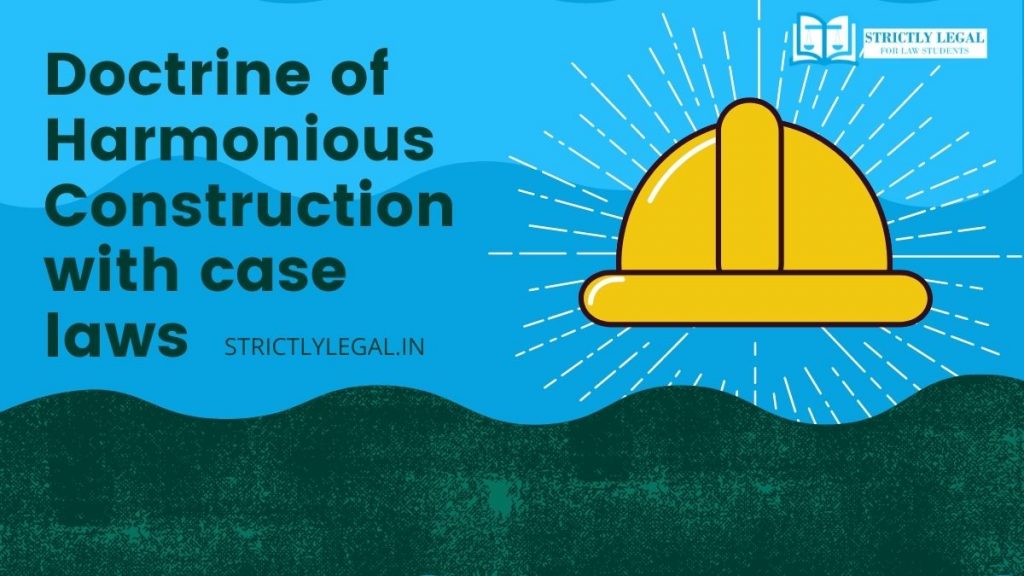In this article we will learn about the doctrine of harmonious construction in Interpretation of statutes and discuss various case laws that have been been adjudicated by appropriate forums on this subject.
Table of Contents
What is the meaning of Harmonious Construction?
When a certain legislative enactment is passed it is ensured that the text of the law is clear and not ambiguous. However, a lot of times perspectives on a particular topic or how a person may see a a particular thing may vary. And due to this, certain ambiguity may arise from time to time.
This is where the role of Judiciary arises, i.e to address these interpretative problems and give a clear view. The court may use several methods of interpretation of statutes in this process, the rule of harmonious construction being one of them.
The doctrine of Harmonious construction states that when two provisions of the same law appears to be giving out contrary views, instead of overruling or repealing any one of those provisions, the courts must bring together both the provisions and interpret it in a way that defeats none, therefore the name harmonious construction.
This is because it is the intention of the legislature to give effect to every provision of law that has been enacted through it. The court cannot interfere with the legislative view unless extraordinary circumstances arise because the legislature carries the mandate of people. Also, ut res magis valeat qauam pereat (legal maxim) being a settled principle of law that states It is better for a thing to have effect than to be made void.
Elements of Harmonious Construction
While Interpreting statutes the following principle of harmonious construction cannot be departed from as has been laid down in :
- Head on clash: It is the duty of the court to avoid a head on clash between the provisions of law and make sure both or all of them are given the force of law and construe them in a manner as to harmonise them.A statue must be reasonably interpreted to make it workable.
- One cannot defeat the other: One provision of law cannot defeat the purpose of another provision. The court must ensure that both the provisions are harmonized unless it leads to absurdity.
- Conflicting provisions: Courts have to bear in mind that when there are two conflicting provisions in the Act which cannot be reconciled with each other, they should be so interpreted that, if possible, effect should be given to both. This is the essence of the rule of “harmonious construction”.
- Dead letter effect: An Interpretation that results in making one of the provisions a dead letter of law is not harmonious construction.
- True Meaning: To harmonise is not to lose the true meaning or give a meaning that the legislature did not intend.
In other words, It is a cardinal principle of Interpretation that the whole of the statute must be read section by section and clause by clause. Every attempt must be made to make the provisions of law as has been laid down workable. The court cannot just pick up one provision of law and interpret it in such a way that it defeats any other provision of law.
Origin of this doctrine
The use of this doctrine can be traced back to the very first Constitutional amendment in the case of Shankari Prasad v. Union of India where there was a conflict between Fundamental rights and Directive principle of state policy. The court applied the rule of Harmonious Construction in Indian constitution and stated that fundamental righst and DPSP are but different sides of the same coins and hence, harmonized them stating they are for public good.
This doctrine has also evolved over the years and specifically after the case of C.P and Berer act where the court held using the rule of interpretation and avoided overlapping or inconsistency between entry 24 and entry 25 of State list and read them harmoniously.
Case laws
In Raj Krushna Bose v. Binod Kanungo, there was a conflict between two provisions, that is Sections 33(2) and 123(8), Representation of the People Act, 1951. According to Section 33(2), a government servant may nominate or second, a candidate seeking election. Whereas according to Section 123(8), a government servant is not entitled to assist a candidate in an election in any manner except by casting his vote.
The court interpreting both the provisions harmoniously held that a government servant was entitled to nominate or second a candidate seeking election to the State Legislative Assembly. Thus, harmony was achieved by allowing a government servant to nominate or second, a candidate as well as by allowing him to vote but he was forbidden to assist a candidate in any other manner.
In Pallawi Resources Ltd. v. Protos Engg. Co. (P) Ltd., the interpretation of the provisions of sub-section (4-A) of Section 17, West Bengal Premises Tenancy Act, 1997 was an issue. The question that arose for the court’s consideration was whether the fair rent in respect of a tenancy, which subsists for 20 years or more in respect of the premises constructed in or before the year 1984 and used for commercial purpose, is required to be determined by the Rent Controller or whether the same would stand automatically determined under sub-section (4-A) of Section 17 read with Section 20, West Bengal Premises Tenancy Act, 1997.
The court observed that a fundamental principle of statutory interpretation is that a provision in a statute must be read as a whole and not in isolation ignoring the other provisions of that statute. While dealing with a statutory instrument, one cannot be allowed to pick and choose. It will be grossly unjust, if the court allows a person to single out and avail the benefit of a provision from a chain of provisions which is favorable to him.
Accordingly, it was held that it will not be appropriate to read sub-section (4-A) of Section 17 ignoring the other relevant provisions. Sub-section (4-A) of Section 17 was not sought to be brought in by way of an exception to the general rule of Section 17.
The Supreme Court in Rahabhar Productions (P) Ltd. v. Rajendra K. Tandon, the court observed that Delhi Rent Control Act, 1958 was a composite legislation — beneficial as well as restrictive in nature. Consequently, the courts are under a legal obligation to read the provisions of the Act harmoniously so as to balance the rights of the landlord and the obligations of the tenants towards each other.
Here, the court has to keep in mind that one of the objects of the legislature while enacting the Act was to curb the tendency of the greedy landlords to throw out tenants paying lower rent, in the name of personal occupation and rent out the premises at the market rates. It must be noted here that in order to ascertain legislative internment, the courts can go behind the words. One provision should be construed with reference to the other so as to make the rule consistent.

Passionate about using the law to make a difference in people’s lives. An Advocate by profession.




